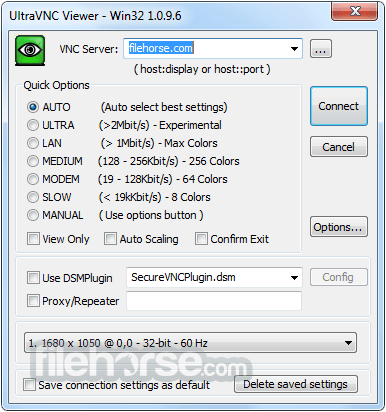

- #SERVER VNC WINDOWS INSTALL#
- #SERVER VNC WINDOWS PASSWORD#
- #SERVER VNC WINDOWS DOWNLOAD#
- #SERVER VNC WINDOWS WINDOWS#
#SERVER VNC WINDOWS WINDOWS#
In Windows File Explorer go to the location you saved both files.Choose Save private key and use a file name like "vnc-server-private.key".Choose Save public key and use a file name like "vnc-server.crt".Follow the instructions onscreen (like moving your mouse randomly).On the computer with the TigerVNC server:
#SERVER VNC WINDOWS DOWNLOAD#
However, you can download a tool to do the job. Unfortunately TigerVNC doesn't understand Windows-style certificates saved in the Windows certificate store or that end with the file extension. Create a certificateįollow the steps for your operating system. However, they are also useful for securing TigerVNC. "X.509" is a standard type of certificate commonly used for websites. Certificates keep private the contents of the communication between you and the remote computer.Certificates prove the identity of the computer you are viewing (the one with the TigerVNC server).Making the connection secure What is a X.509 certificate?Ĭertificates allow three important security functions. I'll post these instructions on the wiki once I get a secure connection working. I'm getting "Authentication failure: authentication failure: Error loading X509 certificate or key". I wrote up draft instructions (below), however haven't quite figured it all out. Password: (password you set up on the server, or leave blank if you want it to ask you every time).Server: (name/IP address of computer on your local network).Protocol: VNC (Virtual Network Computing).If you use another viewer, here's some setting to check: Using TigerVNC's viewer on the remote computer is recommended. On the remote computer enter the IP address/computer name.If you get the same error on this step review the "Firewall setup" section above. This checks the firewall on the server computer is not an issue. Open TigerVNC's viewer on the same computer and connect to your IP address on the network.If you get the same error, review the "Install and setup TigerVNC server" section above. This checks the VNC server is working on your computer. Open TigerVNC's viewer on the same computer and connect to "localhost".Here are a few steps to try to locate the problem. If you get a "Can't establish connection" error.
#SERVER VNC WINDOWS PASSWORD#

#SERVER VNC WINDOWS INSTALL#
Download and install TigerVNC server using the default settings.If it says "Private network" under your connection, skip to "Install and setup TigerVNC server." If it says "Public Network" continue.In the task bar (bottom right), right click on the Network icon and choose Open Network & Internet settings.Then check that your computer knows that you are on a private network (steps below). Any recommendations? Private networkĬheck you are on a private network at home (not a public network). My next step would be to figure out the best way to secure the connection. Okay I got it working and wrote up some basic instructions.


 0 kommentar(er)
0 kommentar(er)
